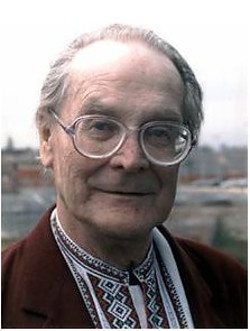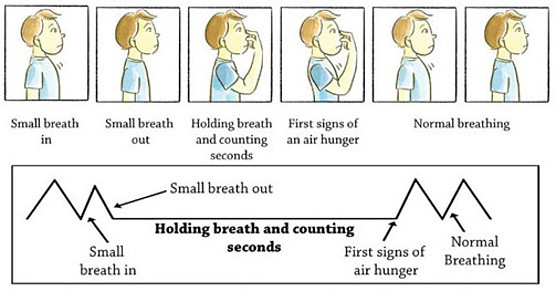Let me guess – You are on this page because of two reasons. One of them is you are either wondering “What is Buteyko Breathing?” or probably you have come across terms like “Buteyko Method” or “Buteyko Breathing” and are seeking more clarity in terms of what exactly is this breathing technique and how to practice it? Give me five minutes and you will have all the answers.
Did you know that your nose is one of the most versatile and elegant organs in the human body? As it humidifies the air you breathe in, it regulates the temperature of the air you breathe, sends signals directly to your brain, and even shapes the sound of your voice. Breathing is by far the most important functions of the body as it ensures proper distribution of oxygen and regulation of body chemistry. The sad part is though most people are unaware that there is a right way and a wrong way to breathing and the wrong way of breathing is contributing to all sorts of health problems.
What is the Buteyko Method
Buteyko Breathing Method is a unique breathing therapy that focuses on the rhythm and rate of breathing. It uses a set of breathing techniques and tools with an aim to slow down the breathing and treat a wide range of health conditions which is connected to hyperventilation and low carbon dioxide.
The name “Buteyko” came from its founder Dr. Konstantin Pavlovich Buteyko from Ukraine who gained his medical degree in 1952. During his medical training, he was given a project to make observations of patients’ breathing rates in relation to the severity of their illness and the chances of their survival. He noticed that the closer the patients came close to death the harder they breathed. He realized a correlation between the patient’s condition and their breathing rate. As the condition of the patient worsens the breathing rate increased. The people who survived the longest seemed to breathe with less effort.
Dr. Buteyko devoted the rest of his life to developing and refining the most effective way to teach people healthy breathing. This way of breathing has become known as Buteyko Breathing.
Why Buteyko Breathing Is Useful
First a…SHOCKING REVELATION!
Deep breathing is found to be optimal and encourages full oxygen exchange however excessive deep breathing can lead to over-breathing and as strange as it seems “if we breathe too much, we actually get less oxygen” – Read this again.
Oxygen deficiency is caused by a lack of carbon dioxide and not by a lack of oxygen. Dr. Buteyko was convinced that hyperventilation causes a depletion of carbon dioxide, which caused blood vessels to spasm and leads to oxygen starvation of the tissues.
If you ever notice someone hyperventilates, you will notice open mouth breathing or taking large breaths prior to talking. There is no pause between exhale and inhale and breathing happens mostly through the upper chest. Buteyko breathing seeks to solve such chronic, low-level hyperventilation.
Due to poor breathing habits, stress, and lifestyle diseases many of us simply breathe too much as a result there is a deficiency of carbon dioxide in our blood. Now you think carbon dioxide as a waste product, however, there are some important things you should know about CO2:
- In order to maintain a normal life, every cell in our body requires a certain concentration of carbon dioxide i.e. around 6.5%.
- It dilates capillary, restores in blood circulation and oxygenates tissues.
- It opens your airways, lack of CO2 causes constriction of airways.
- It reduces histamine levels in the blood.
This is precisely why the Buteyko breathing method is so useful as it aims to regulate and maintain a critical balance of oxygen and carbon dioxide in the body. It teaches you how to bring your breathing volume back towards normal i.e. reverse of chronic over-breathing.
Take The “Control Pause” Breathing Test

Dr. Buteyko developed the Control Pause (CP) breathing test as a simple and reliable measure to check the CO2 level in the lungs. You will need a stopwatch or a clock that has a second hand to count the seconds.
- Sit comfortably on a chair with a straight back.
- Take a few small breaths and after exhaling normally, hold your nose with your fingers.
- Start your stopwatch or look at the second hand of your watch. Hold your breath until you feel the first need to breathe again. The entire breath-hold must be completely effortless. The duration of this breath-hold is called the “Control Pause”
- As soon as you feel the first need to breathe again, release your nose, and resume breathing. The most important thing to remember is the depth of the first breath at the end of the Control Pause (CP) should not be deeper than it was just before you start the breath-hold.
- Having a Control Pause (CP) of less than 25 seconds is poor and 25 seconds to 35 seconds means there is room for improvement. The goal is to reach a comfortable breath-hold time of 40 seconds.
- You should regularly check your Control Pause (CP) after practicing the Buteyko breathing exercises stated below. Ideally, check the CP before the exercise and after the exercise.
- An increase in Control Pause indicated breathing improvement. If it does not, most likely, you did something incorrectly.
How To Do The Buteyko Breathing
The main aim of Buteyko Breathing exercises is to reduce the volume of air that flows through the lungs every minute. It aims to change the depth of breathing, not the breathing rate. You, therefore need to reduce the depth of every inhalation to normal.
Just like an overweight person feels hungry when starting a diet, and an over-breathing person will also feel a lack of air when practicing Buteyko breathing exercises – That’s fine as you get started.
Exercise 1: Relaxation Method
The objective of this exercise is to reduce the depth of breathing and increase CO2 in the lungs through relaxation and developing an awareness of how you breathe.
- Sit comfortably with your back straight.
- Focus on relaxing your body from the head downwards.
- With every breath, pay attention to relaxing your muscles around your stomach, rib cage, and chest.
- Be aware of your breathing and focus at all times on relaxation. Do this for around 5 minutes and the depth of your breathing will naturally start to decrease.
Exercise 2: Holding Your Breath
The objective of this exercise also is to reduce the depth of breathing and increase CO2 by creating a feeling of comfortable air shortage. This can be achieved through willpower by exerting pressure on the breathing process to create a feeling of hunger for air.
- Sir comfortably with your back straight.
- Take 1 or 2 normal breaths.
- As you exhale, hold your nose with your right thumb and index finger. Try not to exhale with force as this will result in immediate discomfort.
- Continue to hold the breath until you feel a slight but comfortable feeling of air shortage.
- Resume breathing again and maintain a comfortable feeling of air shortage with your breathing muscles relaxed.
- Do not try too hard to create an air shortage as this would disrupt your breathing pattern and may lead to deep inhalations, thus causing hyperventilation.
Exercise 3: Many Short Breath-Holds Throughout The Day
This exercise is useful for people who are busy and do not have time during the day to devote time to Buteyko breathing exercises. With this exercise, you can take many short breath-holds at different times throughout the day.
Hold your breath to create a slight air shortage. Hold this breath for about half the length of the Control Pause, avoiding any feelings of discomfort. Then breathe normally for a while.
So if your Control Pause time is 30 seconds then while doing this exercise pause only for 15 seconds and then breathe normally.
Word of Caution
If you have or suspect asthma or any obstructive respiratory symptoms then discuss with your doctor the breathing exercises and do not attempt Buteyko breathing techniques. Also, remember Buteyko breathing exercises are complementary therapy to be used together (if advised by your doctor) with prescribed treatments.
So go ahead and give these exercises a try and let me know in comments how it feels. So breathe peacefully and strengthen your health.
Related Post: Learn How To Unfold The Secret Breath Effortlessly With Pranayama


Hi Satish,
This is very interesting and something I’m going to incorporate into my meditation practice.
I tried the Breathing Test the CP I got is 15 seconds the first time. I’ll be working on that.
The information on CO2 is quite interesting as well. I work in healthcare and the CO2 level is of equal importance when we monitor our patients under anesthesia.
If you go to the Google Search and just type in stopwatch you can time yourself easily. I will certainly be using Buteyko Breathing moving forward.Thank you for the great read.
Hi Teresa,
I am happy you found this post useful and tried the “Control Pause” breathing Test. The CP of 15 seconds is fine as you start out, practice Buteyko Method regularly to enhance the duration of CP ~ Stay Blessed 🙂
Hi Satish,
Great article on Buteyko breathing! I will definitely give these breathing techniques a try! Thanks!
Hi Alyse,
Thanks for you comment, I am happy you found this post useful. Practice Buteyko Breathing regularly to see results ~ Stay Blessed 🙂
Hi Satish,
Interesting article.
I never heard about the Buteyko Breathing. I have come across your article and I wanted to see what kind of method this is. Sometimes I have panic attacks, in the past, I had them during the day but since last year when I have found that my mom has cancer, I started to have them during the night. This method seems easy and I am wondering if will help me to calm down when I have the attacks.
Many thanks for this informative and also for the exercises.
Hi Oana,
Through regular Buteyko Breathing practice we can change the relationship we have with the anxious thoughts and feelings that surface during a panic attack. Next time you get caught up in a swirl of anxious thoughts for a few minutes focus on taking deep, calming breaths. Intentionally breathe slowly and deeply into your belly as you expand your lungs. Then without any effort, exhale naturally. Many people feel relief from anxiety after just a few minutes ~ Stay Blessed 🙂
Hi Satish,
I found your article by chance and wow, am I amazed! I never could have imagined there is such a thing as too much breathing! Although the way you explained it-sounds very real and logical.
I tried the test while I was reading and, well, let’s just say, there is obviously a lot of work to be done here.
I’ve learnt something new and amazing today, thank you very much for this knowledge!
Hi Minaher,
I am glad you found this post useful, thanks for your comment ~ Stay Blessed 🙂
Hello Satish,
Thanks for sharing such an insightful post. There are so many relevant factors that you’ve described here that people often wouldn’t even consider. I love the facts that you’ve thrown in and the picture really makes it clear. It’s interesting how excess breathing can lead to a lack of oxygen, kind of ironic in a way.
Love your page and looking forward to your next article.
Sharon
Hi Sharon,
I am happy you found this post useful and yes it is ironic to know that excess breathing leads to lack of oxygen but it is true. Just as eating too much can be damaging to our health, so can overbreathing. Controlled, deliberate deep breathing should not be confused with ‘big breathing,’ which is taking in bigger-than-necessary volume breaths. This leads to over-breathing and can seriously mess with the delicate balance of the oxygen-carbon dioxide exchange taking place inside your and inside every cell. Stay Blessed 🙂
Hi Satish,
The most shocking statement here and wake up to learn more about Buteyko Breathing is where you stated that “if we breathe too much we actually get less oxygen”. I have noticed that in meditation using other practices you often get light-headed and for some people may even pass out if the breathing parts are done wrong. This explains that to me fully. That is why it makes sense that marathon runners are cautioned to learn to breathe before they learn to run. Thanks for a very informative write up.
Hi Andy,
Yes, over-breathing or hyperventilation can cause you to expel too much carbon dioxide, which impairs blood flow to the brain. If you catch yourself over-breathing (overly big breaths) just remember you can override your nervous system by bringing attention, awareness, and intention to your breathing rate. Extend the exhalations so that they’re longer than the inhalations ~ Stay Blessed 🙂